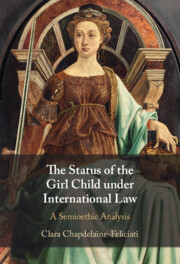Refine search
Actions for selected content:
387 results
Chapter 4 - From Perception to Imagination
-
- Book:
- Kant and the Power of Perception
- Published online:
- 27 November 2025
- Print publication:
- 11 December 2025, pp 126-160
-
- Chapter
- Export citation
Chapter 1 - The Metatheory of the Project
-
- Book:
- Compositional Abduction and Scientific Interpretation
- Published online:
- 20 November 2025
- Print publication:
- 04 December 2025, pp 12-38
-
- Chapter
-
- You have access
- Open access
- HTML
- Export citation
Self-Presentation in International Law: On Reputation and Interpretation
-
- Journal:
- German Law Journal ,
- Published online by Cambridge University Press:
- 13 November 2025, pp. 1-36
-
- Article
-
- You have access
- Open access
- HTML
- Export citation

2 Peter
-
- Published online:
- 31 October 2025
- Print publication:
- 20 November 2025
Chapter 3 - Scientism and the Limits of Objective Thinking
- from Part I - Interrelations
-
-
- Book:
- Science and Humanism
- Published online:
- 09 October 2025
- Print publication:
- 23 October 2025, pp 60-80
-
- Chapter
-
- You have access
- Open access
- HTML
- Export citation
Chapter 3 - Law of treaties
-
- Book:
- International Law
- Published online:
- 26 July 2025
- Print publication:
- 31 July 2025, pp 118-179
-
- Chapter
- Export citation
8 - Jewish Iconography
- from Part I - Architecture and Iconography
-
- Book:
- The Cambridge Encyclopaedia of Late Antique Art and Archaeology
- Published online:
- 04 July 2025
- Print publication:
- 31 July 2025, pp 128-143
-
- Chapter
- Export citation
ÉTALE STRUCTURES AND THE JOYAL–TIERNEY REPRESENTATION THEOREM IN COUNTABLE MODEL THEORY
- Part of
-
- Journal:
- Bulletin of Symbolic Logic , First View
- Published online by Cambridge University Press:
- 03 July 2025, pp. 1-52
-
- Article
-
- You have access
- Open access
- HTML
- Export citation
33 - Legal Interpretation as Coordination
- from Part III - Applications
-
-
- Book:
- The Cambridge Handbook of Experimental Jurisprudence
- Published online:
- 17 May 2025
- Print publication:
- 05 June 2025, pp 546-577
-
- Chapter
- Export citation
12 - Surveys and Experiments in Statutory Interpretation
- from Part II - Introductions
-
-
- Book:
- The Cambridge Handbook of Experimental Jurisprudence
- Published online:
- 17 May 2025
- Print publication:
- 05 June 2025, pp 185-200
-
- Chapter
- Export citation
34 - Legal Ambiguities
- from Part III - Applications
-
-
- Book:
- The Cambridge Handbook of Experimental Jurisprudence
- Published online:
- 17 May 2025
- Print publication:
- 05 June 2025, pp 578-609
-
- Chapter
- Export citation
Is Legal Knowledge Practical?
-
- Journal:
- Canadian Journal of Law & Jurisprudence / Volume 38 / Issue 1 / February 2025
- Published online by Cambridge University Press:
- 25 April 2025, pp. 256-275
-
- Article
-
- You have access
- Open access
- HTML
- Export citation
45 - Legislatures
- from Part III. C - The Democratic System
-
-
- Book:
- The Cambridge Handbook of Constitutional Theory
- Published online:
- 27 March 2025
- Print publication:
- 24 April 2025, pp 792-809
-
- Chapter
- Export citation
Conclusions
-
- Book:
- Genocide in International Law
- Published online:
- 14 March 2025
- Print publication:
- 03 April 2025, pp 787-802
-
- Chapter
- Export citation
15 - Treaty Law Questions and the Convention
-
- Book:
- Genocide in International Law
- Published online:
- 14 March 2025
- Print publication:
- 03 April 2025, pp 722-786
-
- Chapter
- Export citation
The role of subordinating conjunctions in the interpretation of null and overt subject pronouns in native Peninsular Spanish
-
- Journal:
- Applied Psycholinguistics / Volume 46 / 2025
- Published online by Cambridge University Press:
- 21 March 2025, e6
-
- Article
-
- You have access
- Open access
- HTML
- Export citation
10 - Selection of Models with Limited Dependent Variables
-
- Book:
- Quantitative Research Methods in Corporate Finance
- Published online:
- 20 March 2025
- Print publication:
- 20 March 2025, pp 214-249
-
- Chapter
- Export citation

The Status of the Girl Child under International Law
- A Semioethic Analysis
-
- Published online:
- 06 March 2025
- Print publication:
- 13 March 2025
Language justice as an antiracism institutional transformation: Institutional facilitators and barriers for community-engaged cardiometabolic health promotion research
-
- Journal:
- Journal of Clinical and Translational Science / Volume 9 / Issue 1 / 2025
- Published online by Cambridge University Press:
- 24 February 2025, e73
-
- Article
-
- You have access
- Open access
- HTML
- Export citation
Chapter 2 - What Do Historians Do?
-
- Book:
- Teaching History in Higher Education
- Published online:
- 07 February 2025
- Print publication:
- 20 February 2025, pp 61-100
-
- Chapter
- Export citation
